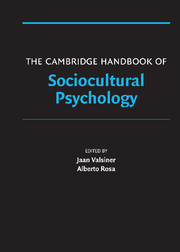Book contents
- The Cambridge Handbook of Sociocultural Psychology
- The Cambridge Handbook of Sociocultural Psychology
- Copyright page
- Contents
- Preface
- Contributors
- The Cambridge Handbook of Sociocultural Psychology
- Editors’ Introduction Contemporary Socio-Cultural Research
- Part I Theoretical and methodological issues
- Part II From nature to culture
- Part III From orientation to meaning
- Chapter 10 Acts of Psyche
- Chapter 11 Time and Movement in Symbol Formation
- Chapter 12 Object Use, Communication, and Signs
- Chapter 13 Network of Meanings
- Part IV Symbolic resources for the constitution of experience
- Part V From society to the person through culture
- Part VI From social culture to personal culture
- Part VII Making sense of the past for the future: memory and self-reflection
- General Conclusions: Socio-Cultural Psychology on the Move
- Index
Chapter 12 - Object Use, Communication, and Signs
The Triadic Basis of Early Cognitive Development
from Part III - From orientation to meaning
Published online by Cambridge University Press: 05 June 2012
- The Cambridge Handbook of Sociocultural Psychology
- The Cambridge Handbook of Sociocultural Psychology
- Copyright page
- Contents
- Preface
- Contributors
- The Cambridge Handbook of Sociocultural Psychology
- Editors’ Introduction Contemporary Socio-Cultural Research
- Part I Theoretical and methodological issues
- Part II From nature to culture
- Part III From orientation to meaning
- Chapter 10 Acts of Psyche
- Chapter 11 Time and Movement in Symbol Formation
- Chapter 12 Object Use, Communication, and Signs
- Chapter 13 Network of Meanings
- Part IV Symbolic resources for the constitution of experience
- Part V From society to the person through culture
- Part VI From social culture to personal culture
- Part VII Making sense of the past for the future: memory and self-reflection
- General Conclusions: Socio-Cultural Psychology on the Move
- Index
Summary
- Type
- Chapter
- Information
- The Cambridge Handbook of Sociocultural Psychology , pp. 257 - 276Publisher: Cambridge University PressPrint publication year: 2007
- 12
- Cited by



